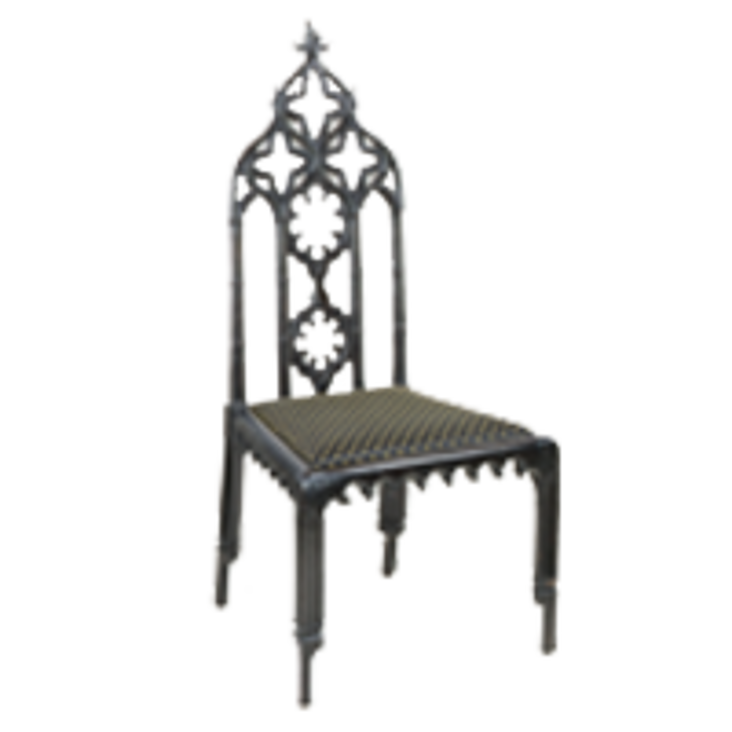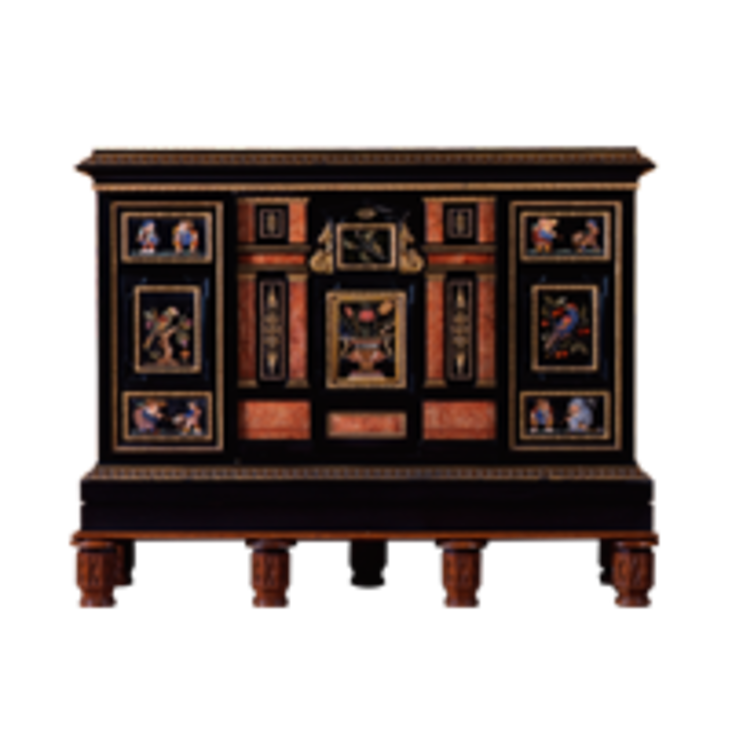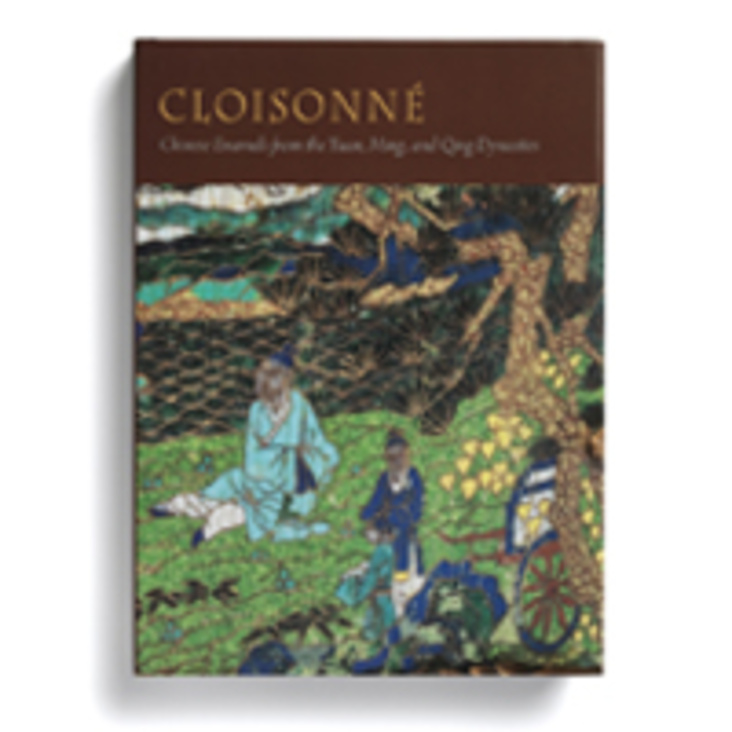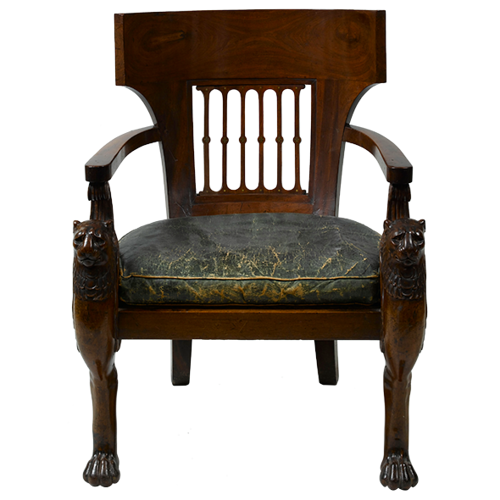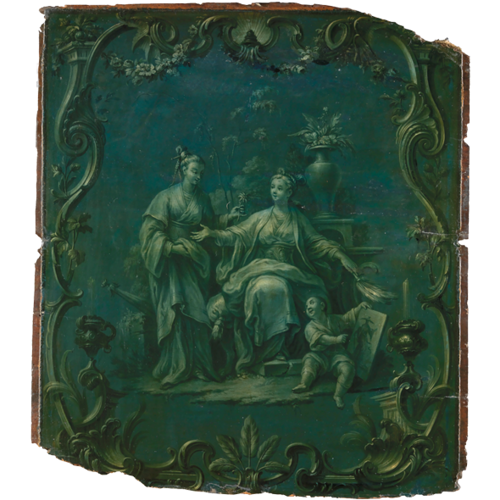Originally published in: Cast Iron From the Central Europe, 1800–1850, edited by Elisabeth Schmuttermeier and Derek E.Ostergard. New York: Published for The Bard Graduate Center for Studies in the Decorative Arts, New York by Hull Printing Co. Inc., 1994. 117–127.
From the exhibition: Cast Iron from Central Europe, 1800-1850.
Excavations in Italy at Pompeii and Herculaneum
in the early eighteenth century sparked an international interest in the study
of ancient civilizations. In one direction, this evolved into the science of collecting
historical gems. Faithful copies of ancient gems, or engraved hard stones, were
made into glass pastes and used again as molds for casts in ceramics, precious
metals, and iron by the nineteenth century. These gems served as documents
verifying cultural and historical developments and became a mainstay in the
study of Neoclassicism.
The collecting of gems began during Roman times. Small cabinets with storage drawers specifically designed for the gems were constructed, and by the middle of the fifteenth century, at least 200 cabinets were known to exist in the Low Countries, 175 in Germany, more than 380 in Italy, and about 200 in France.1 By the mid-eighteenth century this enthusiasm for antiquity, manifest in the collecting of ancient gems, reached an apex in England and Europe. The rise in importance of these gems was further boosted by such publications as Receuil d’antiquités égyptiennes, étrusques, grècques et romains (1756-67) by Anne Claude Philippe, Comte Caylus, and Reflections on the Imitation of Greek Works in painting and Sculpture (1755) by Johann Joachim Winckelmann. “Enormous prices were paid for fine stones, and the high estimation in which engraved gems always were held by men of taste and fashion, must have very early suggested the idea of imitating them in coloured glass compositions.”2 Engraved metallic copies of hard-stone gems became an art form in itself with the delicate touch of the engraver needed to bring the first copy to perfection. Molds were then made from the copies and filled with sulphur and paste. Many eminent artists in eighteenth-century Europe were engaged in this practice, including the German Johann Lorenz Natter (1705-1763), the Tyrolean Antonio Pichler (1697-1779), and his sons Giovanni (1734-1791) and Luisi (1773-1854). In England there was Nathanial Marchant (ca. 1739-1816), and in Rome, Flavio Sirletti (d. 1737) and Giovanni Antonio Santarelli (1769-1826).3 The fervor to collect gems and stones also led to forgery when old and new gems were embellished with the names of ancient artists for the purpose of increasing their value. Outright fakes were often sold as originals establishing a bias against the gem-cutters as forgers rather than artists.
Around 1721, after taking up residence in Italy, Baron Philipp von Stosch (1691-1757), a Prussian nobleman, traveled throughout Europe searching for originals and copies of antique gems. His primary interest was in collecting the gems as historical references confirming ancient literature by such classical writers as Homer and Pliny the Elder. In 1757, after Stosch’s death, Winckelmann wrote a description of the engraved stones owned by Stosch,4 developing a thematic classification system which became the standard arrangement in many future catalogues, for example, in the history of the antique gods or antique mythology.5
In 1784, a book entitled An Essay on Medals reviewed all previous publications from 1548 onward on both ancient and “modern” gems.6 The book emphasized the importance of the study of gems as sources of knowledge for the fine arts, connoisseurship, conservation, and iconography. It gave directions for forming cabinets and advice on the prices of medals. Another book, Select Gems from the Antique (1804), compared the study of gems to the study of painting and sculpture, manners, historical events, and customs of the ancients. “They constitute a library without books, a gallery of pictures without paintings, and sculpture without marble.”7
In England a growing appreciation for reproductions of these gems can be attributed largely to two entrepreneurs of taste, Josiah Wedgwood and James Tassie. Wedgwood (1730-1795) was a potter in the Staffordshire area of England. Through his chemical experiments and marketing skills, his firm was known worldwide by the time of his death. Some 1,700 ceramic gems were offered for sale by Wedgwood in his 1779 catalogue, each marked with a reference number for identification. Wedgwood called these “cameos” (the reverse being intaglios). He wrote that they were “taken from the finest antique Gems … the Price … being ten Times less than any other durable Imitations that have ever been made in Europe, and the Figures are much sharper than in those that are made of Glass … By the Favour of the Nobility, &c. who are in possession of original Gems, or fine Impressions of those in foreign Collections, we have been enabled to make our List pretty numerous … it is perpetually increasing.”8 Later in the same catalogue he restates his claim of excellence: “The superior Hardness, Sharpness, and Correctness of these Intaglios places them far above all other Imitations or copies of antique Gems, yet no Article in the whole extent of the fine Arts has ever been offered to the Public at so moderate a Price.”9
James Tassie (1735-1799), a native of Glasgow, Scotland, came to London in 1766 and rented a showroom near Wedgwood’s at Greek Street in Soho. Tassie offered for sale glass-paste copies of ancient gems that he had made with the assistance of Dr. Henry Quin, a scientist and president of the Royal College of Physicians. The material was composed of powdered glass which in a soft state was pressed into plaster-of-paris molds.
Tassie’s collection of copies of ancient and modern gems was the largest ever assembled, growing to about 15,800 pieces of which about 500 were portraits. Tassie issued three catalogues listing his glass-paste gems, one in 1775 and two in 1791. In the introduction to the 1775 catalogue, he described “antique Gems, in which the merits of the original are so perfectly preserved, that the most eminent connoisseurs have declared their heartiest approbation.” He suggested that the gems could be used in “the Library and Study … ornament[ing] with the heads of Philosophers, Poets, Orators, and heroes.” He further stated that “no means have been looked upon to be more conducive towards correcting the taste of the modern artist, than opportunities of viewing the works of the ancients, and particularly the Antique Gems, which have been carefully collected in the cabinets of the virtuosei in every country in Europe.”10
In 1791 Tassie published his two-volume catalogue listing all 15,800 glass-paste copies available from his collection. The gems were described in the title as “taken from the most celebrated cabinets in Europe; and cast in Coloured Pastes, White Enamel, and Sulphur.” They were arranged and described by R. E. Raspe, who wrote “an introduction on the various uses of this collection, the origin of the art of engraving on hard stone, and the progress of pastes.”11 He referred to “the art of engraving on hard and precious stones, … [as] an art of refined intellectual luxury”12 Raspe further suggested that by studying gems the artist would be exposed to “an inexhaustible supply of ideas” and “a measure of taste”13 and that it would “habituate the eye, better than books or prints, to this science, and serve as a touchstone by which every Gem should be tried, which is offered to sale as an antique of great value, with pompous certificates of its excellence and originality.”14
Both Wedgwood and Tassie promoted their gems through royal patronage throughout the world. Wedgwood’s relations with Prussia began during the mid-eighteenth century when large quantities of his creamware were exported there.15 Britain had favorable relations with Prussia due to their allegiance during the Seven Years’ War (1756-63) when Frederick the Great successfully fought against half of Europe, securing Prussian rule in portions of Central Europe. From the beginning of the Seven Years’ War, English potters sold commemorative pottery with the likeness of Frederick the Great enameled on salt-glazed stoneware teapots, impressed on salt-glazed plates, and drawn on tin-glazed and multicolored metallic oxide earthenware plates. Even Wedgwood used engravings of the king transferred to creamware teapots.
In a letter of February 9, 1758, Horace Walpole remarked on England’s love of Frederick the Great: “All England kept his birthday: it has taken its place on our calendar next to Admiral Vernon’s … the people I believe think that Prussia is a part of Old England … It is incredible how popular he is here: … the lowest of the people are perfectly acquainted with him; as I walked by the river the other night, a bargeman asked me for something to drink to the King of Prussia’s health.”16
In Germany, however, Wedgwood’s usual means of royal patronage was not possible. Here he instituted “voluntaries” or individual salesmen to sell both his useful and ornamental wares directly to the public because he lacked access to the ruling families of the various principalities, electorates, and duchies that constituted the German-speaking world. The plan to deluge the country with salesmen carrying earthenware samples in hopes of enticing export agents to order his ware proved a success. Wedgwood wrote to his partner, Thomas Bentley, on July 29, 1772, “I rejoice with you my Dear Friend that we have some prizes from our expedition in Germany. If a few more should turn up with such letters as these & promises of farther commissions we may in the end have no great reason to repent what we have done in this respect.”17
An extant 1786 catalogue of the German dealer C. C. H. Rost of Leipzig reveals the availability of Wedgwood’s wares in Germany.18 Rost’s list of objects for sale comes directly from Wedgwood’s 1779 catalogue (with additions) and includes 350 portrait and mythological antique gems or cameos, 380 intaglios, 225 bas reliefs as well as sets en suite, busts, figures, antique lamps, déjeuneurs, antique vases, and flower vases and bulb pots.19
During the 1770s orders for Wedgwood’s ornamental creamware vases came from royalty throughout the Continent including Catherine the Great of Russia, the kings of Denmark and Poland, as well as Frederick the Great of Prussia.20 In Wedgwood’s 1774 catalogue, he makes reference to his success saying that through “the liberal Encouragement of many Princes and illustrious Persons on the Continent, … we have been enabled to risque the Expence of continual improvements.”21 To further this success, in June 1790, Josiah Wedgwood II and Thomas Byerley made a salesman’s trip to the Continent taking with them copies of Wedgwood’s now famous Portland Vase22 and a set of eleven commemorative pieces celebrating the upcoming accession and the virtues of Emperor Leopold II, of the Holy Roman Empire. Wedgwood wrote to Byerley later in the year, “One of our papers gives us reason to suppose there will not be any coronation at Frankfurt this year. What do you think of this matter?”23 Leopold was indeed crowned but died in 1792, and his sister Marie Antoinette was guillotined the next year.
Other evidence of Wedgwood’s presence in Europe is seen in the copies of his creamware, basalt, and jasperware by numerous European factories. The rue Popincourt factory at Paris, the Fürstenberg factory, the Douai faience factory, the Ludwigsburg porcelain factory, the Vienna factory, the Sèvres factory, and the Thüringerwald Ilmenau factories, all made some form of Wedgwood’s ware, usually gems and busts, mostly unmarked.24
For Tassie the subscribers’ list in his 1791 two-volume catalogue reveals no immediate orders of copies from Germany with the exception of an order from the University of Gottingen for a “large paper” set. The reason for this dearth of orders may be the access to gems made by Philipp Daniel Lippert (born 1702) of Dresden. Around 1750 Lippert began to copy gems in a “Fine white Alabaster or Selinite Palister, which [was] carefully soaked in a solution of white Castile soap, then dried and rubbed over with a soft brush.”25 He published three different collections of his gems, numbering one thousand each; the first was described by a professor Christ at Leipzig, Dactyliotheca Lippertianauctore Christ. Lipsiae, and the second and third thousand described by Professor Heyne at Güttingen, Dactyl. Lippertiana Myrias, II. III. Auctor. Heyne. Lipsiae. He later took the best two-thousand examples from the three volumes and published yet another book, Lipperto Beschraibung seiner Dactyliotheck, Leizig bry Breitkopf. All were widely subscribed and available in public libraries and universities throughout Germany.26
Yet Tassie was a solid contender elsewhere in the world. His reputation reached Empress Catherine the Great who ordered a complete set of gems in 1783. Tassie referred to his gems as facsimiles and pointed out, most likely in reference to Wedgwood, that since they were not made of clay they did not shrink in the firing nor have air bubbles, and “hence they have a decided superiority over clay or any other material hitherto used in taking impressions.”27 In response Wedgwood noted in his catalogues that “the figures [on] his gems are much sharper than in those that are made of Glass.”28
Despite this apparent rivalry, Tassie supplied Wedgwood with molds for gems and intaglios and Wedgwood reciprocated. Their relations remained cordial and respectful, with Wedgwood noting in a letter of February 24, 1776, that “Mr. Tassie and Voyez between them have made terrible depredations on our Seal Trade. The former by making them more beautifull, and the latter by selling them cheaper …”. 29
Several factors led to the production of cast-iron gems in Prussia. In 1789 a royal iron factory was established at Gleiwitz. In 1790 Friedrich Wilhelm Count von Reden visited England on a study trip to learn more about English iron production. Four years later he perfected the melting of highly fluid iron in cupola furnaces. In 1798 the first gems were made at the Gleiwitz factory from copies that Reden had obtained during his 1790 trip to England.
Gem molding became the primary product of the Gleiwitz factory. Some 1,254 gems were produced there during the first year of manufacture. The molds were later shared with the other royal Ironworks at Berlin and Sayn. By 1803 the production reached a zenith of 15,593 gems available in cast Iron.30 In 1928 there remained in stock “1,510 gems cast in plaster” at Gleiwitz.31
Although no written references to the Prussian factories exist in the ten-thousand documents in the Wedgwood archives,32 there can be no doubt that gems by Wedgwood and Tassie were used as molds for Prussian cast-iron gems. Reputedly made from “glass paste gems by Wedgwood,” Reden’s prototypes for iron medallions were more than likely made by James Tassie, as Wedgwood and Bentley only produced ceramic gems.33
Cast-iron gems of the same subject as found in Wedgwood’s jasperware and basalt and Tassie’s glass pastes are numerous. The themes include portraits of famous people, classical mythology, and historical events. A physical comparison of a Wedgwood gem and a Prussian cast-iron gem of the same subject shows only a slight difference in size, usually the cast-iron example being smaller and less defined. The modeling process of the cast-iron gem accounts for this: a sand mold was made from the Wedgwood or Tassie gem and then fluid iron was poured into the concave impression; accordingly the iron then shrank slightly as it cooled.
Portrait Gems
The sources for Wedgwood’s portrait gems came from coins, medals, ivory carvings, sculpture paintings, engravings, Tassie’s glass-paste gems, and individual requests by patrons, families, and friends. In their catalogue of 1774, Wedgwood wrote “that if Gentlemen or Ladies choose to have Models of themselves, Families, or Friends made in Wax, or engraved in Stones, … they may have as many durable copies of those Models as they please, either in Cameo or Intaglio … at a moderate Expense.”34 Patrons were encouraged to engage Joachim Smith, “an excellent ‘Modeller,’ ” 35 for the production of original works.
Capitalizing on the popularity of Frederick the Great (1712-1786) in England, Wedgwood made at least three different portrait gems of him in 1779 and three of F riedrich Wilhelm II, king of Prussia (r. 1786-97), in 1787. Tassie’s catalogue lists seven portraits of Friedrich Wilhelm III (Tassie numbers 14096-14102) one of which was modeled by Tassie himself after a drawing.36 Other portrait gems found in both jasperware and basalt as well as Prussian cast iron include that of King George III, Admiral Horatio, Viscount Lord Nelson, Benjamin Franklin, George Washington, Carolus Linnaeus, and the duke of Wellington.
There were many modelers of Prussian cast-iron portrait gems, but Leonhard Posch (1750-1831) of Berlin was the most prominent. Posch came to Berlin from Austria in 1804 to work as a modeler at the Royal Porcelain Manufactory, the Royal Ironworks, and the Berlin mint. He is credited with the modeling of over 750 portrait reliefs originally in wax, blue glass, or dark mother-of-pearl.37 Posch was responsible for likenesses of the Prussian royal family, the rulers and military leaders of the Napoleonic era, prominent Prussian scholars, religious leaders, war heroes, scientists, and culturalists of the time.38 His son-in-law, Gottfried Bernhard Loos, also worked at Gleiwitz using coins as patterns for his gems.39 Posch trained Anton Friedrich Konig (born 1756) who in the 1797 exhibition of the works of the Berlin Academy exhibited eight casts, two of which were of Friedrich Wilhelm II and Frederick the Great.40
Classical Gems
Of the hundreds of gems offered by Wedgwood with themes derived from Classical mythology, many are also found in decorative cast iron. Wedgwood’s primary sources for his Classical designs were from gem collections such as that owned by Sir Watkin Williams Wynn, a great patron of Wedgwood, and by the duke of Marlborough (from which he borrowed approximately 245 gems). One example from the duke of Marlborough’s collection, found both in Wedgwood’s ware and cast iron, is of the marriage of Cupid and Psyche (the original is now in the collection of the Boston Museum of Fine Arts). The cast-iron copy of this gem is mentioned in a list of objects sent from London to Reden in Prussia in March of 1790: “four reliefs with two different large Bacchanal illustrations, a wedding celebration and a sleeping Amor.”41 The wedding or “Marriage” gem became one of Wedgwood’s most popular subjects produced in many sizes and all wares.
In the Catalogue of the Exhibition, there are several examples in cast iron of classical themes found in both media. “Hercules in the Garden of the Herperides,” for example, found on a jasperware tablet and a footed bowl in decorative cast iron. “Cupid Stringing His Bow” is seen on a jasperware plaque and a pair of cast-iron earrings. Direct copies in iron in this exhibition include plaques of Terpsichoe and Euterpe and small gems of Hercules with his club, Hercules strangling the Nemean lion, Coriolanus with wife and mother, Venus De’ Medici, Venus and Cupid, Venus hiding Cupid on a dolphin, Neptune riding the sea, and the sacrifice of Hymen. A head of Medusa was used for decoration on a cast iron vase and a Wedgwood Roman scroll and flower design is found as decoration on a cast-iron stand.
Historical Gems
In his first catalogue of 1774, Wedgwood had offered under “Class III section II, Statesmen, Philosophers and Orators of Greece” a series of portrait gems which were provided by Tassie from glass pastes. Reden obtained copies either in glass paste or in one of Wedgwood’s wares in England from which reproductions were made in cast iron in 1798. In 1814 the Gleiwitz factory published their first catalogue of gems42 with a series of “at least 165 oval bust portraits of Greek and Roman emperors, philosophers, statesmen, ideal female figures and medieval Italian Theists.”43 The collection was divided into two parts, with numbers 1 through 60 having a diameter of about 1 3/8 by 1 3/4 inches (3.5 x 4.5 cm) and almost duplicating those listed in section II of Wedgwood’s catalogue. Numbers 61 through 165 had a diameter of 1 5/8 by 2 1/8 inches (4.2 x 5.2 cm), and although no list of these is known, all are antique portraits with two exceptions: number 61, the subject of which is unknown; and number 75 which is of the Italian painter Francesco Albani after a Wedgwood gem of the same subject.44 The cast-iron series was popular for many years, but the later castings were technically better than the first and imprinted with Arabic numbers on the back. Examples in both Wedgwood basalt and cast iron of the first sixty as numbered in the Gleiwitz catalogue are included in this exhibition.
Another historical cast-iron gem portrays a kneeling slave in chains, a direct copy of the example first produced in 1787 by Wedgwood. Wedgwood was a member of the Society for the Abolition of the Slave Trade in England and developed the gems from the society’s emblem for distribution to fellow members in England and America. Surrounding the figure on the Wedgwood jasperware gems is the phrase “Am I not a Man and a Brother” which is not included on the cast-iron gems. The phrase is from “The Dying Negro,” a 1773 poem by Thomas Day.45
About 1790 Wedgwood offered to his public “a series of nineteen horse studies” originally painted by the English equestrian artist, George Stubbs. The gems of the horses were modeled for Wedgwood by Edward Burch (1730-1814) between 1788 and 1790. Two of the horses from the series are also found in Prussian cast iron in this exhibition. Wedgwood said of his basalt stoneware, “Black is sterling and will last forever.”46 The burnt black cast-iron gems made in the Prussian factories had a similarly strong appeal in the early nineteenth century. The visual simplicity of the black material complemented the prevailing taste for the classical style with its emphasis on a black-and-white palette. Meeting the public demand for knowledge of the ancients, Wedgwood, Tassie, and the Gleiwitz factory produced quality reproduction gems.
By the middle of the nineteenth century, however, the Age of Neoclassicism had waned and, coupled with the 1839 invention of the daguerreotype by Louis Jacques Daguerre, the collecting of portrait, classical, and historical gems began to lose favor. No Prussian gems are known with designs from the Aesthetic Movement of the 1860s and 1870s. Only simple castings from old patterns made in iron and nickel alloy are found from the late nineteenth and early twentieth centuries. In the twentieth century, the cast-iron gems and objects from former Prussia reached obsolescence; only an occasional New Year’s card and a few commemorative pieces were still being made.
© Bard Graduate Center, E. Bryding Adams.
All references to letters from Josiah Wedgwood to Thomas Bentley are signified with an E and a number. These are either on loan to Keele University, Stoke-on-Trent, England or at the Wedgwood Museum at Barlaston, England. These letters are cited by kind permission of the trustees of the Wedgwood Museum.
1.Pinkerton, An Essay (1784), p. 8. ↖
2.Tassie and Raspe, A Descriptive Catalogue (1792), p. xliv. ↖
3.Mundt “Ein Lichtschirm” (1875), p. 63-64. ↖
4.Winkelmann, Description des pierres gravée (1760). ↖
5.This classification system was replaced by a chronological system in Furtwängler, Beschreibung der geschnittenen (1896); see Mundt, “Ein Lichtschirm” (1875), p. 62. ↖
6.Pinkerton, An Essay (1784). ↖
7.Murray and Harding, Select Gems (1804), p. 30. ↖
8.Wedgwood and Bentley, A Catalogue (1774), p. 4-5. ↖
9.Ibid., p. 21. ↖
10.Tassie, A Catalogue of Impressions (1775), pp. v-vi. ↖
11.Tassie and Raspe, A Descriptive Catalogue (1792), title page. ↖
12.Ibid., p. ii. ↖
13.Ibid., p. lxiv. ↖
14.Ibid. ↖
15.Reilly, Wedgwood (1989), vol. 1, p. 78. ↖
16.McKendrick, Brewer, and Plumb, Birth of a Consumer Society (1982), p. 250. ↖
17.Josiah Wedgwood to Thomas Bentley, July 29, 1772, E25-18383. ↖
18.Ironically the decorative cast-iron collection at the Birmingham Museum of Art was collected by Herr Gustav Lamprecht a professor of graphic art at the University of Leipzig. ↖
19.Rost, Anzeige aller Kunstwerke (1786). ↖
20.Reilly and Savage, Wedgwood (1973), p. 19. ↖
21.Wedgwood and Bentley, A Catalogue (1774), p. 2. ↖
22.By 1789 Wedgwood had made blue-and-white and black-and-white jasperware copies of the Roman cameo-glass vase owned by the duke of Portland. Ownership was by subscription, thus becoming the first limited edition in the history of ceramics. ↖
23.Reilly and Savage, The Dictionary (1980), pp. 214-215. ↖
24.Reilly and Savage, Wedgwood (1973), p. 20. ↖
25.Tassie and Raspe, A Descriptive Catalogue (1791), p. lviii. ↖
26.Ibid. ↖
27.Ibid, p. lxii. ↖
28.Wedgwood and Bentley, A Catalogue (1774), p. 4. ↖
29.Josiah Wedgwood to Thomas Bentley, February 24, 1776, E25-18657. ↖
30.Hintze, Gleiwitzer Eisenkunstguss (1928), p. 6. ↖
31.Ibid, p. 4. ↖
32.Letter to the author from Mr. M. J. Phillips, Special Collections and Archives, Keele University Staffordshire, England, May 5, 1993. There are, however, numerous documents which record pottery being sent to the Netherlands and Germany. ↖
33.Hintze, Gleiwitzer Eisenkunstguss (1928), p. 6. ↖
34.Arenhovel, Eisen statt Gold (1982), p. 57. ↖
35.Wedgwood and Bentley, A Catalogue (1774), pp. 29-30. ↖
36.Reilly, Wedgwood (1989), vol. 2, p. 737. ↖
37.Bimler, “Modelleure” (1914), pp. 17-18. ↖
38.Arenhovel, Eisen statt Gold (1982), pp. 15-16. ↖
39.Ibid., p. 79. ↖
40.Hintze, Gleiwitzer Eisenkunstguss (1928), p. 6. ↖
41.Ibid., p. 7. ↖
42.Bimler, “Modelleure” (1914), p. 6. ↖
43.Hintze, Gleiwitzer Eisenkunstguss (1928), p. 6. ↖
44.Ibid. ↖
45.Adams, Dwight and Lucille Beeson (1992), p. 106. ↖
46.Josiah Wedgwood to Thomas Bentley, E25-18521. ↖
